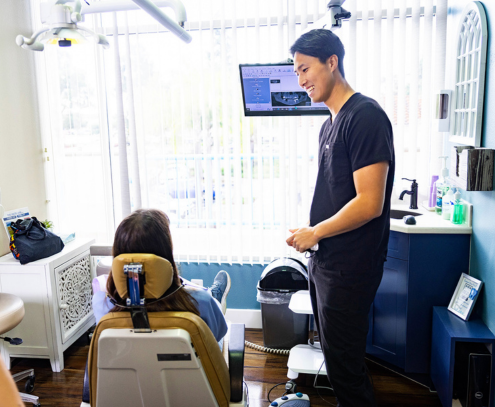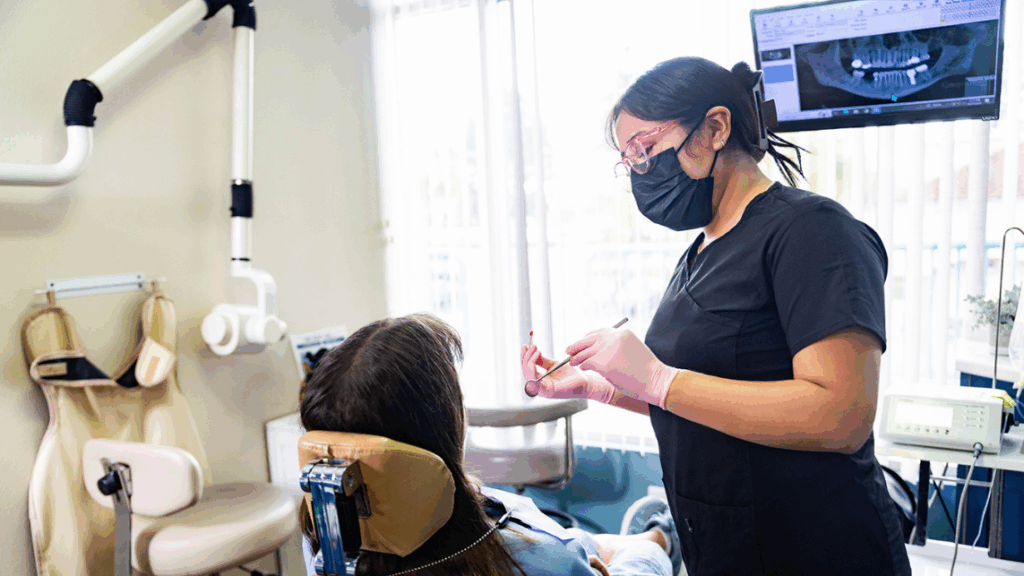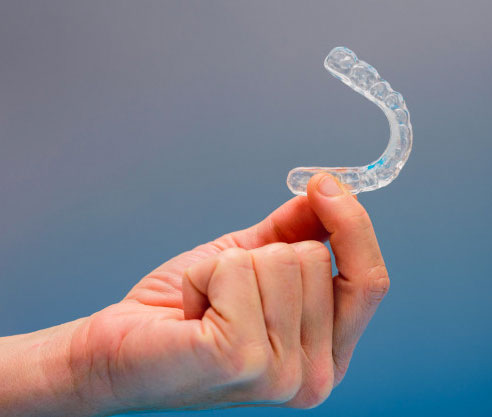PREVENTATIVE DENTISTRY IN MIRA MESA

Preventive dentistry starts with regular dental exams and cleanings
As a trusted Mira Mesa dentist, we believe preventive dentistry starts with regular dental exams and cleanings to maintain lifelong oral health.
We recommend a routine checkup every six months. Our dental checkups begin with a full dental exam. Exams help us detect potential dental problems early. Exams include:
- X-rays, which help us detect tumors, cysts, and bone loss in the jaw
- Screening for oral cancer in the head, neck, and mouth
- Periodontal evaluation to assess the health of the gums
- Evaluation of tooth surfaces for decay
- Inspection of the condition of fillings and crowns
A regular dental cleaning is then performed, also known as a dental prophylaxis. This polishes teeth and helps remove plaque, the sticky substance that inflames gums and causes decay. If plaque hardens it becomes tartar, which can lead to periodontal disease if left unchecked. In this case, we may recommend periodontal therapy.
Dental X-rays: Essential tools for accurate diagnoses
We utilize dental X-rays, also known as dental radiographs, to diagnose various dental conditions. Taken during routine exams, these X-ray images provide our team with invaluable information that enables us to identify and address a range of dental diseases. By utilizing dental X-rays, we can detect and assess the following:
- Abscesses or cysts
- Jawbone loss
- Tumors (both cancerous and non-cancerous)
- Interproximal tooth decay (decay between teeth)
- Developmental abnormalities

Once this examination is complete, your dentist and dental hygienist will determine whether your oral health necessitates a preventative dental cleaning, also called a dental prophylaxis, or whether interventional periodontal therapy is necessary.
Are dental X-rays safe?
It’s normal to have certain assumptions about x-rays due to the radiation used. Most patients just want to know if they’re safe.
The truth is that the amount of radiation you are exposed to during a full-mouth X-ray is comparable to your daily exposure from natural sources. In other words, with standard precautions, dental X-rays are perfectly safe.
That said, we follow a conservative approach and, out of an abundance of caution, only take X-rays when necessary. Before recommending X-rays, we carefully evaluate each patient’s unique situation, taking into account their medical and dental history, age, and overall risk of dental disease.
For new patients, we typically recommend a full mouth series of X-rays, which provides comprehensive information for the next three to five years. Additionally, we advise bite-wing X-rays (X-rays of the upper and lower teeth biting together) once or twice a year to monitor the potential development of cavities between teeth.
Rest assured that your safety and well-being are our top priorities. Our experienced team ensures that the use of dental X-rays is tailored to your specific needs, helping us provide accurate diagnoses and effective treatment plans while minimizing unnecessary exposure to radiation.

Snoring and sleep apnea treatments: Restful sleep and better health
Sleep apnea is a serious condition characterized by interrupted breathing during sleep. Individuals with sleep apnea face a higher risk of heart disease, stroke, and certain types of cancer.
Fortunately, Dr. James Tasto, a proud member of the American Academy of Dental Sleep Medicine, offers effective treatment for Obstructive Sleep Apnea (OSA) using a mandibular advancement device (MAD). A mandibular advancement device (MAD) is designed to hold the lower jaw in a forward position, which in turn brings the base of the tongue forward. By doing so, a MAD creates more space behind the tongue, resulting in a wider airway for improved breathing during sleep.
Understanding the impact of sleep apnea
Left untreated, sleep apnea can lead to various health problems, including:
High blood pressure
- Heart failure, irregular heartbeats, and heart attacks
- Depression
- Stroke
- Diabetes
- Worsening of ADHD
Additionally, untreated sleep apnea can significantly impact daily functioning, such as work performance, academic achievement in children and adolescents, and even increase the risk of motor vehicle accidents. With repeated episodes of interrupted breathing, the brain and the body may not receive adequate oxygen, further exacerbating the condition.
Identifying risk factors for sleep apnea
Sleep apnea can affect individuals of all ages, including children. Several risk factors increase the likelihood of developing sleep apnea, such as:
- Being male
- Being overweight
- Age over 40
- Neck circumference greater than 17 inches for men or 16 inches for women
- Presence of enlarged tonsils, a large tongue, or a small jaw bone
- Family history of sleep apnea
- Gastroesophageal reflux (GERD)
- Nasal obstruction due to a deviated septum, allergies, or sinus problems
We prioritize the identification and treatment of sleep apnea to improve your overall health and quality of life. Dr. James Tasto and our experienced team are dedicated to providing effective solutions tailored to your specific needs. Contact us today to schedule a consultation and take the first step towards a restful night’s sleep.


Mouthguards
Mouthguards aren’t just for children and teens to wear at sporting events. These simple devices can help protect your oral (and overall) health in a variety of settings on and off the field
Nightguards
If you are suffering from jaw pain, sensitive teeth, or broken teeth due to clenching and grinding, our team can help you find relief using a custom-made nighttime mouthguard.
Bruxism, or teeth grinding, is caused by intense jaw clenching during sleep. Left untreated it can cause tooth damage, jaw pain, sore gums, earaches, chronic headaches, and more.
Athletic mouthguards
Athletic mouthguards are an essential piece of athletic equipment for sports that involve the possibility of impacts from falls, body contact, or flying objects. Athletes participating in baseball, football, basketball, soccer, hockey, skateboarding, gymnastics should strongly consider the use of a mouthguard. Not only do properly-fit mouthguards protect your teeth and jaw, they can help benefit protect you from concussions.
How are mouthguards made?
There are three main ways that mouthguards are made.
Custom-made mouthguards are individually designed and made here in our office. This option provides the most comfortable fit and best overall protection, making them a favorite among athletes. The process itself is simple. We take impression of your teeth from which a model is made. A mouthguard is then constructed around that model.
At the opposite end of the spectrum you’ll find stock mouthguards. These are fairly inexpensive from sporting goods stores and are ready to wear as is. However, their one-size approach means they don’t fit well for most people. This type of mouthguard is bulky and provides some level of protection from impacts, but less so than custom-fit mouthguards. They are not especially comfortable for most, and their bulk can make breathing more challenging for athletes.
The middle option is a boil and bite mouthguard. These are also found in sporting goods stores. Boil and bite mouthguards come in a pre-formed shape that is semi-customed by placing the mouthguard in boiling water before biting into it. They are generally more comfortable and provide a better level of protection that stock mouthguards, though they fall short of custom options.
